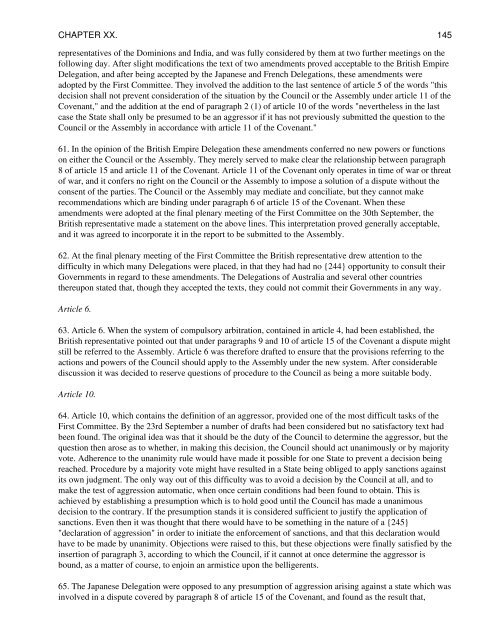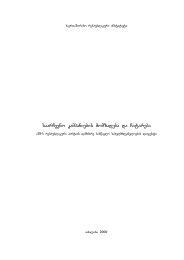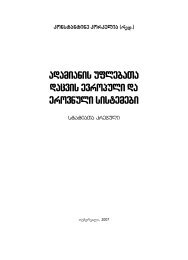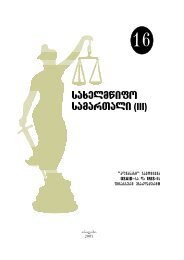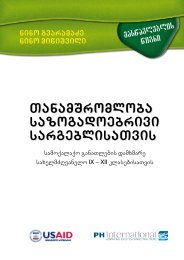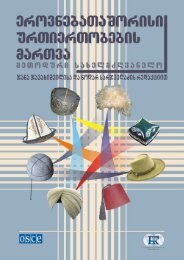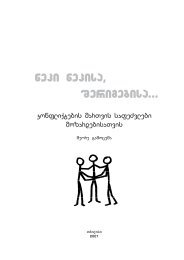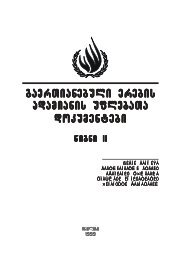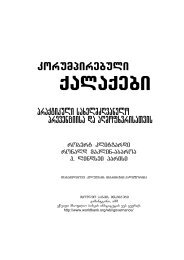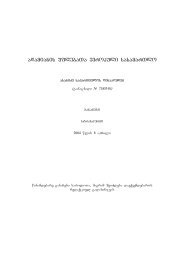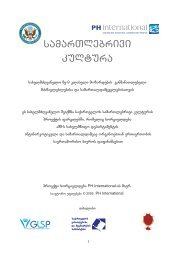The Geneva Protocol, by David Hunter Miller
The Geneva Protocol, by David Hunter Miller
The Geneva Protocol, by David Hunter Miller
You also want an ePaper? Increase the reach of your titles
YUMPU automatically turns print PDFs into web optimized ePapers that Google loves.
CHAPTER XX. 145<br />
representatives of the Dominions and India, and was fully considered <strong>by</strong> them at two further meetings on the<br />
following day. After slight modifications the text of two amendments proved acceptable to the British Empire<br />
Delegation, and after being accepted <strong>by</strong> the Japanese and French Delegations, these amendments were<br />
adopted <strong>by</strong> the First Committee. <strong>The</strong>y involved the addition to the last sentence of article 5 of the words "this<br />
decision shall not prevent consideration of the situation <strong>by</strong> the Council or the Assembly under article 11 of the<br />
Covenant," and the addition at the end of paragraph 2 (1) of article 10 of the words "nevertheless in the last<br />
case the State shall only be presumed to be an aggressor if it has not previously submitted the question to the<br />
Council or the Assembly in accordance with article 11 of the Covenant."<br />
61. In the opinion of the British Empire Delegation these amendments conferred no new powers or functions<br />
on either the Council or the Assembly. <strong>The</strong>y merely served to make clear the relationship between paragraph<br />
8 of article 15 and article 11 of the Covenant. Article 11 of the Covenant only operates in time of war or threat<br />
of war, and it confers no right on the Council or the Assembly to impose a solution of a dispute without the<br />
consent of the parties. <strong>The</strong> Council or the Assembly may mediate and conciliate, but they cannot make<br />
recommendations which are binding under paragraph 6 of article 15 of the Covenant. When these<br />
amendments were adopted at the final plenary meeting of the First Committee on the 30th September, the<br />
British representative made a statement on the above lines. This interpretation proved generally acceptable,<br />
and it was agreed to incorporate it in the report to be submitted to the Assembly.<br />
62. At the final plenary meeting of the First Committee the British representative drew attention to the<br />
difficulty in which many Delegations were placed, in that they had had no {244} opportunity to consult their<br />
Governments in regard to these amendments. <strong>The</strong> Delegations of Australia and several other countries<br />
thereupon stated that, though they accepted the texts, they could not commit their Governments in any way.<br />
Article 6.<br />
63. Article 6. When the system of compulsory arbitration, contained in article 4, had been established, the<br />
British representative pointed out that under paragraphs 9 and 10 of article 15 of the Covenant a dispute might<br />
still be referred to the Assembly. Article 6 was therefore drafted to ensure that the provisions referring to the<br />
actions and powers of the Council should apply to the Assembly under the new system. After considerable<br />
discussion it was decided to reserve questions of procedure to the Council as being a more suitable body.<br />
Article 10.<br />
64. Article 10, which contains the definition of an aggressor, provided one of the most difficult tasks of the<br />
First Committee. By the 23rd September a number of drafts had been considered but no satisfactory text had<br />
been found. <strong>The</strong> original idea was that it should be the duty of the Council to determine the aggressor, but the<br />
question then arose as to whether, in making this decision, the Council should act unanimously or <strong>by</strong> majority<br />
vote. Adherence to the unanimity rule would have made it possible for one State to prevent a decision being<br />
reached. Procedure <strong>by</strong> a majority vote might have resulted in a State being obliged to apply sanctions against<br />
its own judgment. <strong>The</strong> only way out of this difficulty was to avoid a decision <strong>by</strong> the Council at all, and to<br />
make the test of aggression automatic, when once certain conditions had been found to obtain. This is<br />
achieved <strong>by</strong> establishing a presumption which is to hold good until the Council has made a unanimous<br />
decision to the contrary. If the presumption stands it is considered sufficient to justify the application of<br />
sanctions. Even then it was thought that there would have to be something in the nature of a {245}<br />
"declaration of aggression" in order to initiate the enforcement of sanctions, and that this declaration would<br />
have to be made <strong>by</strong> unanimity. Objections were raised to this, but these objections were finally satisfied <strong>by</strong> the<br />
insertion of paragraph 3, according to which the Council, if it cannot at once determine the aggressor is<br />
bound, as a matter of course, to enjoin an armistice upon the belligerents.<br />
65. <strong>The</strong> Japanese Delegation were opposed to any presumption of aggression arising against a state which was<br />
involved in a dispute covered <strong>by</strong> paragraph 8 of article 15 of the Covenant, and found as the result that,


